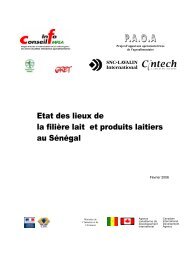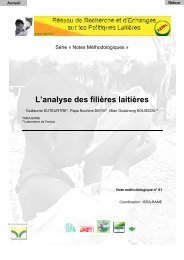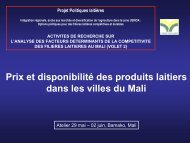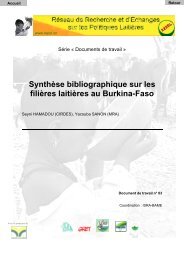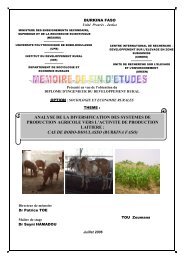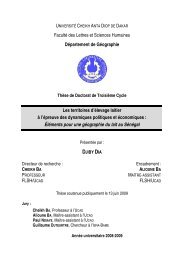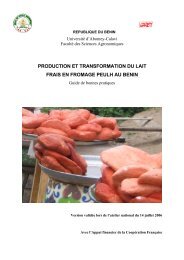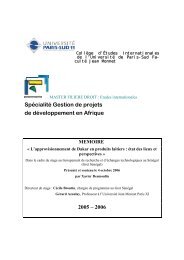Analyse de la consommation du lait et des produits laitiers : - REPOL
Analyse de la consommation du lait et des produits laitiers : - REPOL
Analyse de la consommation du lait et des produits laitiers : - REPOL
- No tags were found...
You also want an ePaper? Increase the reach of your titles
YUMPU automatically turns print PDFs into web optimized ePapers that Google loves.
RésuméLa démographie <strong>et</strong> l’urbanisation croissante dans les villes <strong>du</strong> Burkina Faso ont entraînéune forte augmentation <strong>de</strong> <strong>la</strong> <strong>de</strong>man<strong>de</strong> en <strong>la</strong>it <strong>et</strong> pro<strong>du</strong>its <strong>la</strong>itiers. Face à l’insuffisance <strong>de</strong> <strong>la</strong>pro<strong>du</strong>ction locale, le pays recourt aux importations qui engendrent <strong>de</strong>s sorties d’importantes<strong>de</strong>vises indispensables pour le développement. Pour renverser c<strong>et</strong>te tendance <strong>et</strong> contribuer àré<strong>du</strong>ire <strong>la</strong> pauvr<strong>et</strong>é en milieu rural, plusieurs actions ont été initiées. Cependant force est <strong>de</strong>reconnaître que ces actions ont essentiellement concerné l’amont <strong>de</strong> <strong>la</strong> filière, notammentl’amélioration génétique <strong>et</strong> <strong>la</strong> santé animale. Malgré ces efforts, <strong>la</strong> <strong>consommation</strong> <strong>de</strong>s pro<strong>du</strong>itsimportés <strong>de</strong>meure toujours importante <strong>et</strong> <strong>la</strong> pro<strong>du</strong>ction locale a <strong>du</strong> mal à percer le marché.C’est donc pour améliorer <strong>la</strong> <strong>consommation</strong> <strong>de</strong>s pro<strong>du</strong>its locaux que c<strong>et</strong>te étu<strong>de</strong> <strong>de</strong> <strong>la</strong><strong>consommation</strong> <strong>de</strong> <strong>la</strong>it <strong>et</strong> <strong>de</strong>s pro<strong>du</strong>its <strong>la</strong>itiers a été envisagée. Elle a été menée dans <strong>la</strong> ville <strong>de</strong>Bobo-Diou<strong>la</strong>sso, second pôle <strong>de</strong> <strong>consommation</strong> <strong>de</strong> pro<strong>du</strong>its <strong>la</strong>itiers au Burkina Faso. Elle a visé<strong>la</strong> quantification <strong>de</strong>s flux <strong>du</strong> <strong>la</strong>it local, l’i<strong>de</strong>ntification <strong>de</strong>s principaux types <strong>de</strong> pro<strong>du</strong>its <strong>la</strong>itierscommercialisés dans <strong>la</strong> ville <strong>et</strong> l’étu<strong>de</strong> <strong>de</strong>s déterminants <strong>de</strong> <strong>la</strong> <strong>consommation</strong> <strong>du</strong> <strong>la</strong>it <strong>et</strong> <strong>de</strong>spro<strong>du</strong>its <strong>la</strong>itiers. Pour ce faire, nous avons procédé à une étu<strong>de</strong> bibliographique pour <strong>la</strong>quantification <strong>de</strong>s flux <strong>du</strong> <strong>la</strong>it local, puis à une enquête au niveau <strong>de</strong>s circuits <strong>de</strong> distribution <strong>et</strong><strong>de</strong>s unités <strong>de</strong> transformation pour l’i<strong>de</strong>ntification <strong>de</strong>s pro<strong>du</strong>its <strong>la</strong>itiers <strong>et</strong> enfin, à une enquête« indivi<strong>du</strong>s » pour l’étu<strong>de</strong> <strong>de</strong>s déterminants <strong>de</strong> <strong>la</strong> <strong>consommation</strong>. En ce qui concerne les flux,pendant <strong>la</strong> saison <strong>de</strong>s pluies, 1 991 litres <strong>de</strong> <strong>la</strong>it frais <strong>et</strong> 126 litres <strong>de</strong> <strong>la</strong>it caillé, en moyenne,entrent quotidiennement dans <strong>la</strong> ville. En plus, 229 boules <strong>de</strong> beurre sont quotidiennementenregistrées <strong>du</strong>rant c<strong>et</strong>te saison. En saison sèche par contre, les flux baissent <strong>et</strong> passentquotidiennement à seulement 602 litres <strong>de</strong> <strong>la</strong>it frais <strong>et</strong> 126 litres <strong>de</strong> <strong>la</strong>it caillé en moyenne.En ce qui concerne l’i<strong>de</strong>ntification <strong>de</strong>s pro<strong>du</strong>its sur le marché, nous avons pu constaterune gran<strong>de</strong> diversité <strong>de</strong> pro<strong>du</strong>its importés <strong>et</strong> locaux au rang <strong>de</strong>squels, <strong>du</strong> <strong>la</strong>it frais pasteurisé,<strong>du</strong> <strong>la</strong>it caillé <strong>et</strong> <strong>du</strong> yaourt.En ce qui concerne les déterminants, l’étu<strong>de</strong> révèle d’une part, <strong>la</strong> forte influence <strong>du</strong>revenu sur <strong>la</strong> <strong>consommation</strong> <strong>de</strong> <strong>la</strong>it <strong>et</strong> <strong>de</strong>s pro<strong>du</strong>its <strong>la</strong>itiers avec <strong>de</strong>s dépenses mensuellesmoyennes en <strong>la</strong>it <strong>de</strong> 2 129 F CFA, 3 065 FCFA, 3 212 F CFA, 5 467 F CFA <strong>et</strong> 5 000 F CFArespectivement pour un revenu inférieur à 30 000 F CFA, compris entre 30 000 <strong>et</strong> 60 000 FCFA, entre 60 000 <strong>et</strong> 90 000 F CFA, entre 90 000 <strong>et</strong> 150 000 F CFA <strong>et</strong> supérieur à 150 000F CFA. D’autre part, il ressort que <strong>la</strong> situation matrimoniale influence également <strong>la</strong><strong>consommation</strong> <strong>du</strong> <strong>la</strong>it. Ainsi, les résultats ont montré que les mariés dépensent plus dans l’achat<strong>de</strong> pro<strong>du</strong>its <strong>la</strong>itiers que les célibataires, en moyenne 2 278 F CFA contre 2760 F CFA. L’étu<strong>de</strong>a également permis d’i<strong>de</strong>ntifier <strong>de</strong>s critères <strong>de</strong> qualités importants pour les consommateurs <strong>et</strong>stimu<strong>la</strong>nt leurs achats. Il s’agit <strong>de</strong> l’hygiène évoquée par 26% <strong>de</strong>s personnes enquêtées, <strong>du</strong> prix(22%), <strong>du</strong> goût (17%), <strong>de</strong> <strong>la</strong> disponibilité (10%), <strong>de</strong> l’embal<strong>la</strong>ge (10%), <strong>de</strong> <strong>la</strong> facilité d’usage (7%) <strong>et</strong> <strong>de</strong> <strong>la</strong> conservation (7%). En ce qui concerne le prix, l’analyse <strong>de</strong> <strong>la</strong> sensibilité révèle unefourch<strong>et</strong>te <strong>de</strong> prix acceptables <strong>de</strong> 500 à 550 FCFA le litre pour le <strong>la</strong>it pasteurisé contre 1 000 à1 400 F CFA le kilogramme <strong>de</strong> yaourt.Mots clefs : Pro<strong>du</strong>its <strong>la</strong>itiers, <strong>consommation</strong>, déterminants, sensibilité au prix.III






